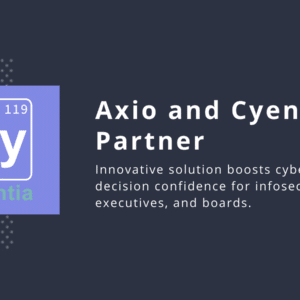The cyber landscape is evolving rapidly with new opportunities and threats branching off of every new technological breakthrough. From operational resilience to leadership structures, the decisions IT leaders make today will set the stage for their org’s success — or vulnerability — in the years to come.
In 2025, we expect to see significant advancements in how organizations manage risk, adopt new technologies, and adapt to an increasingly complex regulatory environment. Whether it’s embracing impact modeling to enhance resilience planning or redefining the role of security leadership, these trends will shape the future of cybersecurity and influence how enterprises approach risk and innovation.
This blog explores the five key trends (as listed below) that will drive transformation in cybersecurity strategies, tools, and roles, highlighting how forward-thinking organizations can stay ahead in the year ahead:
- The “north star” of resiliency planning will shift to impact modeling
- Ease of use becomes the #1 CRQ requirement
- CRQ will be increasingly tapped by non-IT teams and external partners
- Robust risk quantification will drive tech stack decisions
- The traditional CISO role will expand — and for some, it will split in two
1. The “north star” of resiliency planning will shift to impact modeling
For years, cybersecurity planning has focused on probability analysis, i.e., assessing the likelihood of cyber incidents and targeting high-risk systems or attack vectors for fortification. This approach involves estimating how likely specific threats are to occur and using those probabilities to prioritize resources. While helpful, probability analysis often emphasizes prevention over preparation, providing little value in the event that a high-impact incident does occur.
In 2025, impact modeling will take center stage as the foundation of resiliency planning. Instead of focusing solely on the likelihood of an event, impact modeling evaluates the tangible consequences of a cyber incident, e.g., financial losses, operational disruptions, reputational damage, and regulatory penalties. This approach provides a clear understanding of how incidents could ripple through an organization, enabling teams to prioritize mitigation and recovery efforts based on the severity of potential outcomes.
Recent events illustrate why this shift is necessary. Disruptions such as Delta Airlines’ grounded flights, Seattle-Tacoma International’s delays, and Lurie Children’s Hospital’s canceled procedures underscore the critical importance of planning for tangible, operational impacts. In these cases, the operational and financial consequences far outweighed the value of knowing the probability of the incidents occurring.
By shifting to impact modeling, security leaders can build actionable plans to minimize damage and recovery time. By analyzing the potential financial and operational consequences in detail, organizations can make smarter decisions, prioritize resources more efficiently, and build stronger long-term resilience.
Read more about How to Shift Your Cybersecurity Focus from Breach to Impact (& Manage Risk) in my recent byline on Cybersecurity Insiders.
2. Ease of use becomes the #1 CRQ requirement
In 2025, usability will take center stage as CRQ solutions become essential tools for both security teams and non-technical stakeholders. Gone are the days when cybersecurity decisions rested solely in the hands of IT leaders; today, cross-functional participation is a necessity. This trend takes shape in two chief ways:
- Simplified CRQ with business-friendly insights: Traditional CRQ methods often overwhelm non-technical users with complex workflows and technical jargon. Modern solutions address this by offering simplified, user-friendly interfaces that still deliver high-fidelity, business-relevant insights. By translating risks into terms like financial impact or operational disruption, CRQ becomes a tool everyone — from IT teams to finance leaders — can engage with, fostering better collaboration and alignment.
- Faster time-to-value: Legacy CRQ approaches typically require extensive upfront data collection, delaying actionable results. Modern tools prioritize quick time-to-value, generating initial insights from minimal inputs, such as high-level risk scenarios or cost estimates. These insights provide a tangible starting point, enabling faster decision-making while refining accuracy as more data is gathered.
By emphasizing accessibility and speed, CRQ tools in 2025 will empower organizations to make faster, more informed decisions that align with the goals of both business and technical teams.
Learn more about Axio’s Quantification Wizard and how it is helping organizations quantify cyber risks in business terms and make smarter decisions with a fraction of the time and effort.
3. CRQ will be increasingly tapped by non-IT teams and external partners
In 2025, CRQ adoption will expand beyond security teams, transforming how organizations and their partners collaborate on risk management.
The expanded suite of CRQ users include:
- CFOs: Internally, CFOs will leverage CRQ to prioritize investments, optimize insurance coverage, and model the financial impacts of cyber events on balance sheets, ensuring better alignment between financial strategy and risk management.
- Brokers and Insurers: Externally, brokers and insurers will use CRQ to establish a common language with enterprise clients. By translating cyber risks into actionable business terms, they can help enterprises secure tailored insurance coverage, empower brokers to provide better solutions, and enable insurers to expand offerings while managing risks responsibly.
- Financial Players: Private equity firms, credit rating agencies, and investors will adopt CRQ to assess cyber risks across their portfolios. By modeling the financial impact of cyber scenarios, they will gain deeper insights into resilience, financial viability, and overall portfolio quality, driving smarter investment decisions.
As these new audiences embrace CRQ, the need for user-friendly, business-focused tools will grow. CRQ must deliver actionable insights for internal decision-makers while facilitating collaboration with external partners through a shared, business-oriented risk language.
Hear industry experts from Axio and Forrester discuss the practical tips to ensure quantification efforts are actionable, defensible, and easy to implement
4. Robust risk quantification will drive tech stack decisions
CRQ will play an increasingly critical role in guiding decisions around technology investments, whether adopting new technologies or managing legacy systems.
For new technologies, CRQ enables organizations to weigh operational benefits against potential risk exposures. For instance, when considering an AI-powered tool, enterprises can model the financial impact of potential vendor data breaches or misconfigurations, ensuring risks are accounted for before adoption.
When it comes to legacy systems, CRQ sheds light on the financial risks posed by outdated or unsupported technologies, allowing organizations to prioritize tech debt reduction based on its impact on resilience.
By using CRQ to inform these decisions, enterprises can ensure their tech stack aligns with their risk tolerance and resilience strategies.
5. The traditional CISO role will expand — and for some, it will split in two
As the global regulatory landscape becomes more complex, the role of the CISO will necessarily evolve as well. Beyond overseeing data and information security, CISOs will increasingly take on responsibilities related to compliance management and boardroom disclosure.
In this expanded role, CISOs must engage with a broader range of business functions, navigating regulations like Europe’s DORA or new U.S. frameworks for utilities. Some CISOs will adapt to these challenges, thriving in the expanded scope. Others, however, may see their responsibilities split into two distinct roles: a technical lead focused on security operations and a business-focused lead managing compliance and regulatory oversight.
This separation will become increasingly necessary as regulatory demands grow, allowing security teams to maintain focus and efficiency in the face of mounting complexity.
Looking ahead
2025 will be a transformative year for cybersecurity, as organizations balance the need to innovate with the imperative to safeguard their systems and data. From enhancing collaboration between security and business stakeholders to evolving how technology decisions are made, these trends reflect a broader shift toward resilience, adaptability, and strategic foresight.
As the industry continues to grapple with the rising complexity of threats and regulations, enterprises that proactively address these trends will be better equipped to fortify their operations and maintain a competitive edge. Whether adopting new frameworks, refining leadership roles, or leveraging tools that enhance risk visibility, the organizations that embrace change will position themselves for long-term success.
By focusing on operational impact, aligning technology decisions with risk tolerance, and fostering cross-functional collaboration, companies can ensure their cybersecurity strategies remain dynamic and effective in 2025 and beyond.
Want to discuss these trends and how they impact your cyber security strategy? Schedule time to speak with an Axio expert today.




